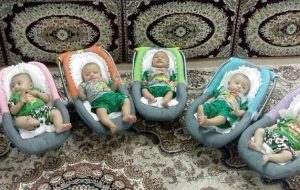Over 26,000 multiple births registered in 8 months
TEHRAN –Within the first eight months of the current Iranian calendar year that started March 20, a total of 26,470 multiples were born in the country, according to the Civil Registration Organization. Tehran, Khuzestan, and Khorasan Razavi provinces had the highest number of multiple births with 2,012, 1,100, and 1,094 cases respectively, ISNA reported. Out


TEHRAN –Within the first eight months of the current Iranian calendar year that started March 20, a total of 26,470 multiples were born in the country, according to the Civil Registration Organization.
Tehran, Khuzestan, and Khorasan Razavi provinces had the highest number of multiple births with 2,012, 1,100, and 1,094 cases respectively, ISNA reported.
Out of the 665, 893 registered births, 12,527 were twins, 445 were triplets, 19 were quadruplets, and one was higher-order multiple births.
Over 1m births registered in a year
A total of 1,057,948 births were registered in the country in the past Iranian calendar year (March 2023 – March 2024), the Civil Registration Organization has announced.
Tehran province with 131,176 births and Semnan province with 6,907 births had the highest and lowest number of births, IRNA reported.
Out of registered births, 51.8 percent were boys and 48.2 percent were girls.
According to the Organization, a total of 33,080 multiple births were registered in the country in the first ten months of the past Iranian calendar year that ended on March 20, 2024.
Twins made up the majority of multiples born; 31,320 out of 33,080 registered multiple births were twins, and 1,686 births were triplets, IRNA reported.
Tehran province with 14.7 percent and Semnan province with 0.5 percent had the highest and lowest number of multiple births, respectively.
Last year, out of the registered multiple births in the first nine months, 28,148 were twins, 1,506 were triplets, 64 were quadruplets, and 10 were higher-order multiple births.
Some 34.6 percent of registered births were first-born children; 38.9 percent, 17.6 percent, 5.1 percent, and 2 percent were related to second-born to fifth-born children.
In the first nine months of the past Iranian calendar year, more boys than girls were born. Over 51.8 percent of babies born were boys and 48.2 percent were girls.
Youth population law stabilizes total fertility rate
Enacting the youth population law has stabilized the total fertility rate, slightly increasing the general fertility index over the past two years.
After experiencing seven years of decline by about 20 percent, the fertility rate is now stabilized at around 1.6, IRNA reported.
The total fertility rate has experienced a sharp decline since the Iranian calendar year 1394 (2015-2016) as the number of births reached 1.057 million in 1402 (2023-2024) from 1.570 million in 1394. However, since the Iranian calendar year 1401 (March 2022–March 2023), the downward trend in fertility came to a halt.
The total fertility rate has lowered to 1.6 children per woman from about 2 children per woman.
According to Civil Registration Organization’s report, the total fertility rate in Iranian years 1396 (2017-2018), 1397 (2018-2019), 1398 (2019-2020), 1399 (2020-2021), and 1400 (2021-2022) were 2,09, 1.95, 1,74, 1.65, 1.61 per each woman, respectively.
At best, Iran’s population with a total fertility rate of 2.5 will reach 102,890,000 by the next seven years, IRIB quoted Mohammad-Javad Mahmoudi, an official with the Civil Registration Organization, as saying.
In May, Hasan Farshidi, an official with the health ministry, said two years after the implementation of the law on supporting families and the youth, investigations have shown that the health ministry has played a central role in the implementation of the law.
“Since the implementation of the law, the number of births among mothers aged 20 to 24 has notably increased,” the official added.
The rate of mothers giving birth to three children increased from 16 percent in the Iranian year 1398 (March 2019-March 2020) to 18.97 percent in 1402 (March 2023 –March 2024) and even the fourth childbirth increased from 5 percent to about 7 percent, Farshidi stated.
MT/MG
